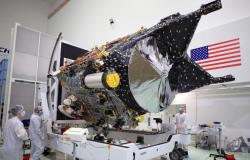A new mission to Jupiter will reveal possible traces of life even on a simple grain of ice: here’s everything we know about the expedition.
One of the main objectives of current space missions is to find traces of life beyond our planet: do they really exist, and how can we identify them? Among the main candidates for hosting possible microorganisms are the icy moons of Jupiter and Saturn. The presence of water, albeit in a solid state, is in fact one of the fundamental characteristics for supporting life as we know it. And soon one new mission it will delve right into the deepest space, with instruments so powerful that they can even record tiny molecules coming from a single grain of ice.
The new mission to Europa
Let’s take a small step back. A few years ago, the Cassini mission (which concluded in 2017) discovered the presence of parallel cracks near the south pole of Enceladus, Saturn’s moon. From these cracks, which hide an underground liquid ocean located at a deeper level than the frozen surface, plumes containing gas and grains of ice. If we could analyze them closely, perhaps we would finally be able to find out if microorganisms are found there.
The new Europa Clipper mission of NASA, which should start next October 2024, will have the objective of studying Europa, one of Jupiter’s main moons, under whose icy crust there now almost certainly exists an ocean of liquid water. The probe that will approach the satellite will carry much more advanced instruments, which are capable of finding traces of life even on a single grain of ice. “For the first time, we demonstrated that even a small fraction of cellular material could be identified by a mass spectrometer on board a spacecraft,” he said. Fabian Klennerresearcher at the University of Washington and lead author of the study published in Science Advances.
The experiment to find life forms
To prepare for mission to Europa, scientists conducted an interesting experiment. Not being able to simulate grains of ice flying at a speed of between 4 and 6 km per second, as would happen in space, they used an experimental device that detects small droplets of water in a vacuum. The study focused on Sphingopyxis alaskensis, a tiny bacterium found in the waters off Alaska. Usually it is usedEscherichia coli, but the unicellular organism considered by the researchers is much smaller, lives in cold environments and can survive even with very few nutrients. It could therefore be the perfect model of type of life that can exist on Europa.
The results of the experiment demonstrate that the tools supplied by the Europa Clipper probe they can detect this bacterium (or even portions of it) in a single grain of ice. All that remains is to understand why cells should be embedded in ice grains. The idea is that the molecules, present in the liquid ocean beneath the ice layer, are transported out of the cracks in the ice through gas bubbleswhich explode on the surface of the moon and drop bacterial material, which begins to freeze.
“With adequate instrumentation, such as the SUrface Dust Analyzer on NASA’s Europa Clipper space probe, it may be easier than we thought to find life, or traces of it, on the icy moons. If life is present there, of course. And if it is embedded in grains of ice coming from an environment such as an underground water reservoir” – he said Frank Postbergprofessor of Planetary Sciences at the Freie Universität Berlin and co-author of the study.






